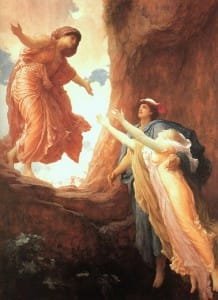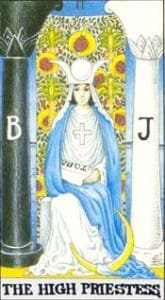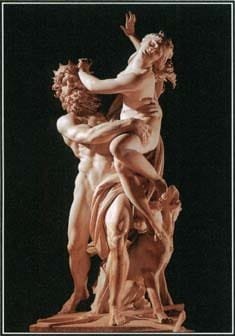Hidden within the different symbols of the High Priestess card is the story of Persephone. Drawn from Greek Mythology, this story is a fascinating look into the hidden depths suggested by the High Priestess card. Today lets look into this story, and understand its connection with that card and its symbols.
The story of Persephone owes its origins to a Greek Myth. In those stories, she was often referred to as Kore (which means ‘maiden’).
Via this story, we will learn about how Persephone represents that aspect of the feminine principle that can and does straddle all the aspects of duality that is evident in the world.
The Story of Persephone: Act I
 Persephone was the daughter of Demeter (the Goddess of Grain and all growing things) and Zeus (the King of all the Olympian Gods). She was said to be very beautiful. In fact, she was such a beauty, that several different Gods tried to ask for her hand in marriage. But Demeter refused, and kept Persephone away from all of them. Thus, Persephone grew up, sheltered from these realities of the world. She lived a very happy life though, living as she was with the Goddess of Grain as her mother. Never lacking for sunshine and warmth, she was shy and timid and in essence a lovely girl.
Persephone was the daughter of Demeter (the Goddess of Grain and all growing things) and Zeus (the King of all the Olympian Gods). She was said to be very beautiful. In fact, she was such a beauty, that several different Gods tried to ask for her hand in marriage. But Demeter refused, and kept Persephone away from all of them. Thus, Persephone grew up, sheltered from these realities of the world. She lived a very happy life though, living as she was with the Goddess of Grain as her mother. Never lacking for sunshine and warmth, she was shy and timid and in essence a lovely girl.
But her father, Zeus, had other plans for her. Due to Demeter’s unrelenting attitude about Persephone’s marriage, Zeus promised Persephone to his brother Hades, who was the God of the Underworld. And Demeter had no idea what was going to happen next.
The Story of Persephone: Act II
One fine day, Demeter was out picking flowers with some friends of hers. Soon enough, she wandered away. Spotting some Narcissus flowers, she bent down to pluck them. Hades chose just this very moment to make his move. He opened up a chasm in the very spot, and reached out from the Underworld to grab Persephone.
He then took her to his kingdom, and kept her there. Some accounts say that he raped her. Some accounts say that he loved her. But at the end of it all, Persephone actually fell in love with him too!
She then became his Queen – the Queen of the Underworld.
 One of the important things that happened (apart from their falling in love, that is), is that she ate (either 3 or 7 or 1) seed(s) of a Pomegranate. Now, everyone knows that if you eat or drink something while you are in the Underworld, you have to stay there forever. So, Persephone essentially chose to remain with her beloved in the Underworld.
One of the important things that happened (apart from their falling in love, that is), is that she ate (either 3 or 7 or 1) seed(s) of a Pomegranate. Now, everyone knows that if you eat or drink something while you are in the Underworld, you have to stay there forever. So, Persephone essentially chose to remain with her beloved in the Underworld.
Meanwhile, back in the world, Demeter was getting very distraught over the loss of her daughter. She searched high and low for her. And she asked everyone, including Zeus, about her whereabouts. Of course, no one said anything. Depressed, she stopped blessing the crops and the grain, and all these growing things stopped growing. A great famine began to plague the world. Finally Helios, the Sun God, relented and revealed the story to Demeter. After all, he had seen everything.
Of course, this made her angry with Zeus for going behind her back like that. So Zeus decided that a little diplomacy was in order, and he sent Hermes (the Messenger of the Gods) to negotiate with Hades.
The Story of Persephone: Act III
 Hermes, knowing full well what he was getting into, went to speak with Hades and resolve the situation. If he didn’t bring Persephone back, there would be famine and hunger in the entire world. But on the other hand, Hades was a stubborn and cold sort of a guy, and very much enamored of his bride. The stakes were quite high.
Hermes, knowing full well what he was getting into, went to speak with Hades and resolve the situation. If he didn’t bring Persephone back, there would be famine and hunger in the entire world. But on the other hand, Hades was a stubborn and cold sort of a guy, and very much enamored of his bride. The stakes were quite high.
It took a bit of an effort, but finally an agreement was reached between Hades and Demeter. Persephone would go and live with her mother for the most part of the year. But for at least four months, she would come back to the Underworld and live with her husband.
And so, Persephone was returned back to Demeter.
The Story of Persephone: The Symbolism
Here are some aspects of the story and its underlying symbolism that jumped out at me:
- By being the daughter of Zeus and Demeter, Persephone represented a very interesting confluence of ‘powers’ as it were. She was someone who potentially represented the combination of growth, abundance and ruler ship.
- Demeter keeping her shielded from the different goings on in the world showed us the effort that her mother took to keep her pure and innocent – untouched, as it were, from the disenchanted and jaded attitude that can develop while interacting with the so-called ‘realities of life’.
- While many Gods wanted to marry her or woo her, the only one who managed to get her father’s permission was Hades, the God of the Underworld. And then he managed to abduct her as well, thus bringing her into his home, his kingdom and his life. The Underworld might typically be the place where all the dead souls went off to, but to me it also represents the mysterious and hidden aspects of life that cannot be accessed by just about everybody (you have to be dead to go there, right?). By winning her father’s approval, Hades showed a lot of promise and succeeded where others did not. Thereafter, he brought Persephone, someone who represented a mix of abundance and growth and power, into a place which held the deeper mysteries of life.
- When Persephone decided to stick around with Hades, it shows that she had accepted what had come her way. She now became the recipient of the hidden mysteries and the deeper knowledge that they implied, along with the inherent, latent powers that she already represented. Thus, Persephone became knowledgeable, not only the aspects of power, and growth, but also in the aspects of death, and the result of all this was the knowledge of the process of regeneration. It isn’t a surprise then that Persephone is also referred to as the Goddess of Spring – the season of regeneration.
Thus, this actually makes Persephone a very powerful Goddess indeed. Yet, if we study the myths, we find that she neither runs after any power, nor does she misuse or mishandle it. In fact, she continues to remain aloof and shies away from the other Goddesses most of the time. She prefers to remain with her husband, sharing his Kingdom and loving him, and she also stays with her mother, loving her and being her dutiful daughter – and all this means that half of her life is spent in darkness, and the other in light.
Persephone represents a woman who can and does cross over from one side to the other frequently and easily. She has a lot of knowledge – of things that grow, of things that die, and of things that regenerate. Thus, she indeed is someone who truly understands the hidden and evident mysteries of life.
The Story of Persephone: The High Priestess Card
 Persephone in the context of the High Priestess card thus represents the energies of the feminine that are innocent, and yet aware of deeper, mysterious things.
Persephone in the context of the High Priestess card thus represents the energies of the feminine that are innocent, and yet aware of deeper, mysterious things.
With her knowledge, she sits in the Temple shown in the card. She is calm and balanced – sitting as it were in the middle of the pillars of duality. And yet, she is unfazed by the brilliance of her own knowledge.
Behind her veil, flows the water of the Unconscious mind – the pool of the Universal knowledge that holds all the answers to all the questions. She sits there, with the veil hiding that knowledge, yet giving us enough of a hint of its presence. She knows that each of us must discover our own hidden selves by ourselves, and she won’t ever prevent us from doing so.
List of References
Most myths have myriad versions. For this article, I chose a particular version that was close to the first version of this myth that I had heard many years ago. However, there are several websites on the Internet that will give you the other versions, and / or add into the meanings, thoughts, and ideas etc. that have been expressed in this article. Please feel free to go through them, and read for yourself!
- The Wikipedia page about Persephone
- Some very in-depth and interesting information about Persephone
- A very well written article about Persephone
Your Turn / In Conclusion…
So, what did you make of this story? Did you like it? Was it interesting? What are your thoughts about the connection of the story of Persephone and the different symbolism within the High Priestess card in Tarot?
Please do share your thoughts and ideas in the comments section below.



Upon further investigation I found a very compelling description of how Demeter in her despair is helped, encouraged, and supported by Baubo, the Neolithic Belly Goddess, whom she meets up with, the sun Helios, and the old crone Hecate all who help Demeter to find Persephone. This story is found in Clarissa Pinkola Estes’ book, Women Who Run With The Wolves.
Hmm.. Interesting.. I’ll check out that book…
You know, its an amazing coincidence.. You are the second person in these past couple of weeks to mention that book to me… Must be something, eh…
Wonderful article! I love Persephone, my favourite card in Mythic Tarot deck. I have found The High Priestess ( Persephone ) has the most to teach me!
Me too! In any deck i buy or see, that is the first card that I check out!! 🙂
I have always been interested in Greek Mythology..somehow it feels closer to Indian Mythology than the Egyptian one.
Having said this,I love the above article it’s beautifully written and also very lucid. Having drawn this card a couple of times,it’s nice to understand a bit more about”Kore”.
Keep it flowing 🙂
Thanks for your kind thoughts Bhairavi…
Yes, I have often found that most mythologies overlap each other somewhere, somehow.. I stumbled onto the works of Joseph Campbell a few months ago, and he too pretty much says the same thing.. 🙂
The egyptian cult of osiris-isis has nearly overshadowed the divinity of pluto-persephone.
While osiris is mortal, pluto is the source of mortality
Osiris and isis are paternal, while pluto and persephone are conjugal.
Since pluto-persephone rule the underworld they rule the inherent process of birth decay and death within each living organism and particle in the universe. Time is subservient to pluto-persephone. Cronos who rules time is found even below Hades.
Hence the outermost planet and its transplutonian, persephone are both the portals for liberation of souls and for the inlet of divine energy, they rule the fundamentals of creation, preservation and destruction. Pluto and persephone are complementary and cannot subsist without the other. Kore identified with flowers is innocence, the underworld is not floral rather graphic, an innocent kore ruling the underworld is what empowerment is all about.
Hey Jennifer,
Thanks for your comment.. 🙂
Again, gave me a bunch to think about.
You are right – Persephone and Pluto / Hades – the combination, although seemingly strange, does complement each other!
Madhavi
Surprised to see no comments on such a beautiful article. Perhaps it requires a personal experience of one to post on something as complex as Pluto-Persephone. I have long been blogging on astrology sites and had written quite a few articles considered controversial by pop astrologers.
Demeter: The earth goddess is the archetypal Narcissistic Virgo mother who ties her daughter to her apron strings. She creates KORE as her own mirror image and world sees Kore as a junior demeter.
Kore: Fed on the routine pop astrology the general public has a preconcieved and a fanciful notion of what each sign looks like. For instance Taurus females are percieved to be the salt of the earth, feminine, fertile, beautiful, dancing in a fruit garden with a tiara of rosebuds. Reality is just the opposite. Kore is the typical innocent Libra girl. Libra girls are not all business women. People get their idea of Libra on seeing Margaret Thatcher or any one of those sirens walking the ramp. False. Earth is the true ruling planet of Libra with Persephone as the CORE (KORE) holding the truths of life and death. Many a Libra girl is mothered by an earth sign mother who is overshadowing and overdomineering
Hades is the god of the underworld. The rape here is not a physical one, rather a painful penetration of the vestiges and layers of Persephone’s mind to empower her and liberate her from the clutches of her mother.
When a Persephone does meet her Hades, she is torn between her societally useful obligation towards her narcissitic mother versus her soul nourishing love of Hades. She thinks loving any one apart from her mother is a sin, because narcisstic parents cannot stand competitors to their worship and adoration. What Demeter had towards Persephone was smothering and not mothering.
It is also a point of note that Demeter feeds the young Persephone morsels. This is in accordance with narcissists who like to weaken their victims psycho-emotinally so that their authroity remains unquestioned. When she willingly elopes with Pluto, the first gift he gives her is sumptuous food. After all the most nourishing food is found underworld.
Before encountering Pluto, Kore is pre-menstrual, immature and pre-teen, for lack of food delays sexual maturity. Pluto’s masculine presence and love and his abundant nourishment brings out the woman in her. I could go on and on…. You can find my Facebook profile as rgopipluto vanitha proserpina
Hey Jennifer,
Thanks so much for your comments!
You have a very interesting perspective on the whole Demeter – Persephone – Hades relationship… And it is certainly worth looking deeper into!
I quite liked your statement: “The rape here is not a physical one, rather a painful penetration of the vestiges and layers of Persephone’s mind to empower her and liberate her from the clutches of her mother.” It makes a lot of sense from the point of view of symbolism.
Also the part about food and nourishment is something that is very, very interesting.
I never really did see Demeter as an overbearing mother, but now that you mention it… 🙂
I always did feel that somehow, Persephone’s meeting Hades and falling in love with him did symbolize a more deeper freedom for Persephone. With her mother, her own identity was just Demeter’s daughter. But with Hades, she finds a way to her true self… The journey to the underworld, to me, symbolizes one’s journey into the deeper, darker, hidden aspects of the self, which, upon discovering and accepting, can make us whole. Kinda like embracing the Shadow…
Thanks so much for your thoughts.
They gave me a lot to ponder about…
Madhavi